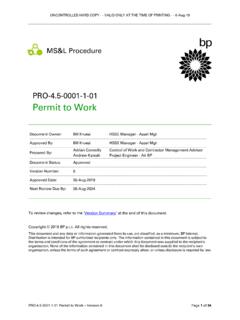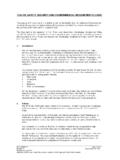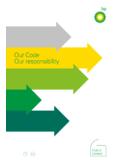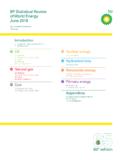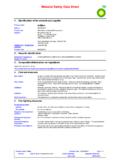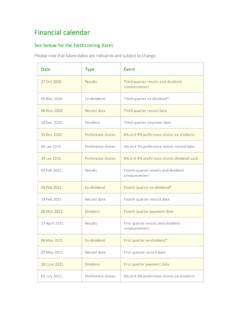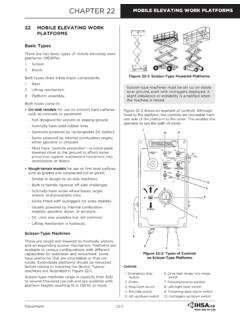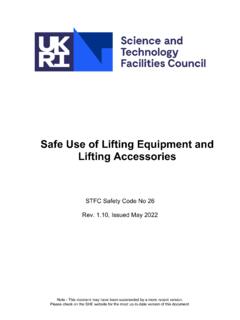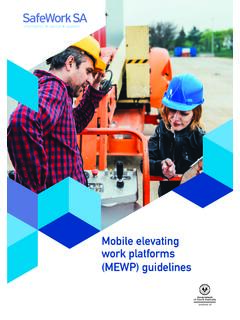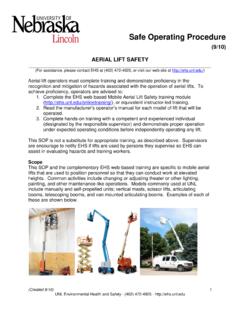Transcription of Lifting and Rigging - BP
1 BP Pipelines and Logistics (USPL) Lifting and Rigging Safety Manual Page 1 of 19. Lifting and Rigging 1. Purpose By following this policy and operating Lifting devices in a safe and responsible manner, injuries and property damage can be prevented. 2. Scope This policy applies to all persons who operate cranes ( mobile, stationary, overhead), aerial cages, any other mechanical Lifting devices with associated Rigging , and other equipment used for Lifting , such as backhoes, excavating equipment, truck-mounted hoists, other hoists, and chain falls. The policy does not apply to forklifts, manlifts, personnel- elevating work platforms, earth-moving equipment, or similar equipment used in its intended manner and without Rigging .
2 If any situation arises not specifically covered by this policy, a Lifting plan shall be developed and approved by the DOM before proceeding. 3. Minimum Requirements Supporting Minimum Requirements Documentation 1. Lifts shall be evaluated for their criticality in the planning stage of the job or by the Sections 7 and 8. Lift Operator prior to the execution of the lift. All lifts identified as a Critical Lift require a completed Critical Lift Permit. 2. All Critical Lift Permits shall be issued by an Asset Operator or Asset Operator Section 8. Designee and shall be received by a Performing Authority.
3 Self-permitting is prohibited. 3. For Non-Critical Lifts, the Authorization to work form shall be used prior to the Section 9. execution of the lift. A permit is not required. 4. All individuals serving in roles defined within this policy shall be competent to Section 11. execute those roles according to this policy. 5. All personnel performing work on behalf of USPL have the responsibility and Section 6. authority to stop any Lifting operation they consider to be unsafe. 4. Definitions Anti-two-block device A device designed to warn the crane operator that the hook block is about to hit the boom head, which could have serious consequences (damage to the crane or cable breakage, causing the load to fall).
4 Asset Operator (AO) A BP employee who is responsible for the operation of the asset where work is being performed. The Asset Operator shall be accountable for the asset equipment being in a safe condition for the scope of work to be performed. The Asset Operator or an Asset Operator Designee (if used) is responsible for the completion of the ATW form. Asset Operator Designee (AOD) A BP employee or contractor individual who is authorized to issue ATWs and / or permits on behalf of the Asset Operator. Revision Date: September 15, 2015 Effective Date: January 1, 2016.
5 Next Review Date: September 15, 2020. Paper copies are uncontrolled and valid only at the time of printing. The controlled version of this document can be found in DRM. in the HSSE Policies folder. BP Pipelines and Logistics (USPL) Lifting and Rigging Safety Manual Page 2 of 19. Note: Reference the Authorization to work policy for additional information Chain fall An example of a hoisting device consisting of a chain suspended from or laid over a fixed structure such as a beam, or on well built saw horses resting on well supported joists used to lift heavy objects, such as steel beams and vehicle engines.
6 Depending on the situation there are many other temporary rigs that be improvised for Lifting heavy objects with the tool. This principle is very similar to a block and tackle. Crane Power-operated equipment that can hoist, lower and horizontally move a suspended load. Such equipment includes, but is not limited to: Articulating cranes (such as knuckle-boom cranes); crawler cranes;. floating cranes; cranes on barges; locomotive cranes; mobile cranes (such as wheel-mounted, rough-terrain, all-terrain, commercial truck-mounted, and boom truck cranes); multi-purpose machines when configured to hoist and lower (by means of a winch or hook) and horizontally move a suspended load; industrial cranes (such as carry-deck cranes); dedicated pile drivers; service/mechanic trucks with a hoisting device; a crane on a monorail; tower cranes (such as a fixed jib, , "hammerhead boom"), luffing boom and self-erecting).
7 Pedestal cranes; portal cranes; overhead and gantry cranes; straddle cranes; sideboom cranes; derricks; and variations of such equipment. Critical Lift A lift that meets, at a minimum, any of the following conditions: Any lift exceeding 75% of the charted capacity of the crane or Lifting devices used Note: In no case shall the lift exceed 90% of the charted capacity of the crane except when load testing a crane is conducted by or under the direction of a qualified third-party Lifting equipment vendor, which does not require a critical lift permit.
8 Load testing shall be risk-assessed as part of the Authorization to work process. Tandem lift with two cranes Note: A tandem lift with two cranes does not apply to pipeline lowering or raising on the Right of Way, but it does apply to pipeline pulling associated with a horizontal directional drill regardless of whether cranes or other Lifting devices are used. Transfer of the load from one Lifting device to another Lifts utilizing an aerial cage Any lift within 20 feet of electrical lines or substations Note: In no case shall a lift be conducted closer than 10 feet from an electrical line or substation.
9 Any lift exceeding 25,000 pounds Use of any boom or boom extension with a combined length greater than 99 feet A mobile crane situated on unstable or uneven ground or traveling while carrying a load Note: This criteria does not apply to cranes and other Lifting devices used for the movement of materials on the Right of Way or facility roadways. Lifting operations when they are subject to sudden uncontrolled movement (dynamic lifts), lifts to or from vessels, boats, barges, etc. Note: The collective judgment of those involved in the lift shall be used to determine if conditions exceed normal parameters, making the use of a Critical Lift Permit necessary to verify all personnel are in agreement that a safe lift can be made.
10 Lifts involving raising or lowering a load from, into, or over an occupied confined space or building If the load passes over any process equipment, exposed live piping in a facility, or a live underwater pipeline Note: Connecting hoses to ships and barges is excluded from this criteria. Any lift made while a diver is in the water Revision Date: September 15, 2015 Effective Date: January 1, 2016. Next Review Date: September 15, 2020. Paper copies are uncontrolled and valid only at the time of printing. The controlled version of this document can be found in DRM.
